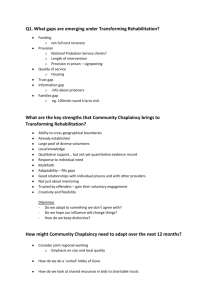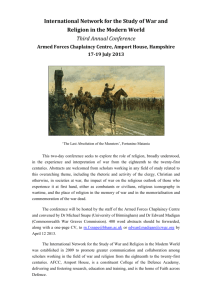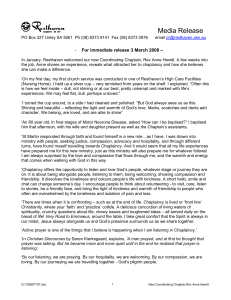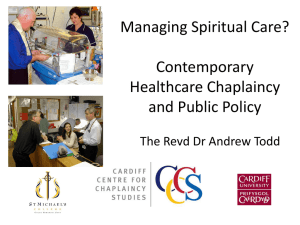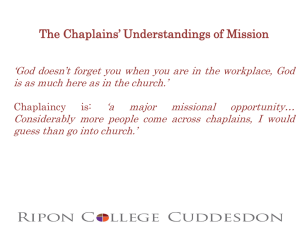Advancing Effective Communication, Cultural Competence
advertisement
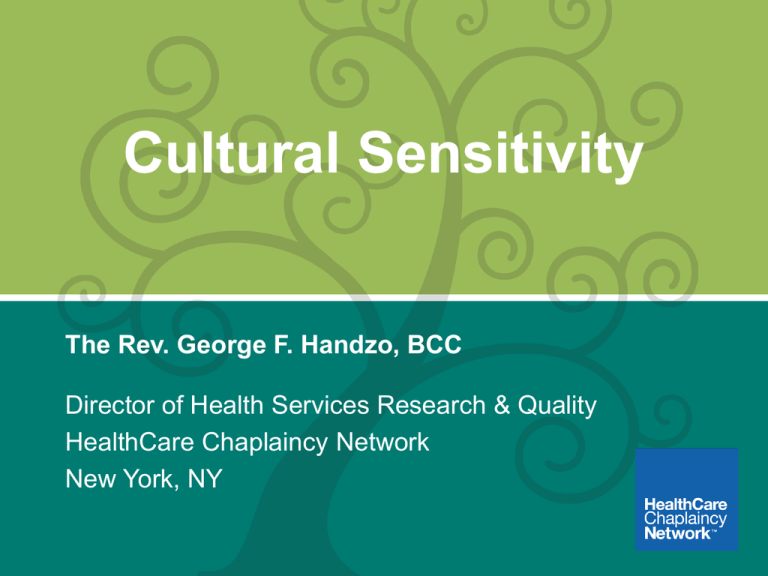
Cultural Sensitivity The Rev. George F. Handzo, BCC Director of Health Services Research & Quality HealthCare Chaplaincy Network New York, NY The End Game A health care institution where patients, family members and staff can live out their spiritual and religious beliefs, values, and practices within the bounds of mutual respect and safe health care practice. # © HealthCare Chaplaincy 2 A New Mindset Not about avoiding anything that might possibly offend someone. Not about minimizing risk It’s about “why not” rather than “why” It’s about customer service and patient-centered care It is about employee satisfaction and retention # © HealthCare Chaplaincy 3 Cultural Competence/Sensitivity Being culturally sensitive or competent does NOT mean knowing everything about every culture... It is instead respect for differences, eagerness to learn, and a willingness to accept that there are many ways of viewing the world. # © HealthCare Chaplaincy 4 Ethnicity A group of people whose members identify with each other, through a common heritage, consisting of a common language, a common culture (often including a shared religion) and a tradition of common ancestry. # © HealthCare Chaplaincy 5 Culture The learned or shared knowledge, beliefs, traditions, customs, rules, arts, history, folklore and institutions of a group of people used to interpret experiences and to generate social behavior. # © HealthCare Chaplaincy 6 Spirituality Spirituality is the aspect of humanity that refers to the way individuals seek and express meaning and purpose and the way they experience their connectedness to the moment, to self, to others, to nature, and to the significant or sacred. # © HealthCare Chaplaincy 7 What Are You Own Predispositions? # © HealthCare Chaplaincy 8 Attitudes What causes illness? What does it mean to be a “good patient”? How to treat illness and injury? Who do you go to? # © HealthCare Chaplaincy 9 Attitudes- Right and Wrong Is it whatever works for the patient/service member? What is “wrong”? # © HealthCare Chaplaincy 10 Aspects of Culture # © HealthCare Chaplaincy 11 Aspect of Cultural Sensitivity Attitudes Knowledge and Comprehension Skills Desired Outcome- Internal-External Deardorff, D.K. (2004) Identification and Assessment of Intercultural Competence as a Student Outcome of Internationalization.; Journal of Studies in International Education. 10: 241-266, # © HealthCare Chaplaincy 12 Aspects of Cultural Sensitivity Individual Organizational # © HealthCare Chaplaincy 13 Aspects of Cultural Competence Facilitate- food, worship, prayer space & time Provide- worship Care- culturally sensitive care Advise- policy making, accommodation # © HealthCare Chaplaincy 14 Health Care Culture Beliefs a) Standardize definitions of health and illness b) The omnipotence of technology Practices a) Maintenance of health and prevention of disease via mechanisms such as the avoidance of stress and the use of immunizations b) Annual physical examinations and diagnostic procedures such as Pap smears Habits a) Charting b) Constant use of medical jargon c) Use of a systematic approach and problem solving methodology Likes a) Promptness b) Neatness and organization c) Compliance Dislikes a) Tardiness b) Disorderliness and disorganization Customs a) Rituals a) Physical examination b) Surgical procedure c) Limiting visitors and visiting hours Professional deference and adherence to the “pecking order” found in autocratic and bureaucratic systems b) Hand washing c) Employment of certain procedures attending birth and death # © HealthCare Chaplaincy 15 Aspects of Culture Sense of self and space Informal, handshake Formal, bows, handshakes Communication and language Explicit, direct. Emphasis on content – meaning found in words Implicit, indirect. Emphasis on context --- meaning found around words # © HealthCare Chaplaincy 16 Aspects of Culture Dress and appearance “Dress for success” ideal. Wide range in accepted dress Dress seen as a sign of position, wealth, prestige. Religious rules Jewelry & hair Food and eating habits Eating as a necessity – fast food Dining as a social experience. Religious rules # © HealthCare Chaplaincy 17 Aspects of Culture Time and time consciousness Linear and exact time consciousness. Value on promptness. Time = money Elastic and relative time consciousness. Time spent on enjoyment of relationships Relationships, family, friends Focus on nuclear family. Responsibility for self. Value on youth, age seen as handicap Focus on extended family. Loyalty and responsibility to family. Age given status and respect # © HealthCare Chaplaincy 18 Aspects of Culture Values and norms Individual orientation. Independence preference for direct confrontation of conflict Group orientation. Conformity. Preference for harmony. Beliefs and attitudes Egalitarian. Challenging of authority. Individuals control their destiny. Gender equality. Hierarchical. Respect for authority and social order. Individuals accept their destiny. Different roles for men and women. # © HealthCare Chaplaincy 19 Aspects of Culture Mental processes and learning Linear, logical, sequential, problem-solving focus. Lateral, holistic, simultaneous. Accepting of life’s difficulties. Work habits and practices Emphasis on task. Reward based on individual achievement. Work has intrinsic value. Emphasis on relationships. Rewards based on seniority, relationships. Work is a necessity of life. # © HealthCare Chaplaincy 20 Aspects of Culture Communication of medical information Death & dying Keeping the Sabbath # © HealthCare Chaplaincy 21 Use of Authority Traditional Negotiating Individualistic # © HealthCare Chaplaincy 22 It’s All About Assessment 23 Cultural/Religious Issues Beliefs Values Family structure Modesty Food Dress Daily Religious Observance Ritual Items End-of-life care Mourning # © HealthCare Chaplaincy 24 Assessment Issues Stereotypes Cultural Patterns # © HealthCare Chaplaincy 25 Goal of Chaplaincy Helping patients discover and use their spiritual and religious resources in the service of their healing. What is “healing”? # © HealthCare Chaplaincy 26 Cultural Discussion PRESERVE beliefs and practices that have a beneficial effect on health. ADAPT OR ADJUST those that are neutral or indifferent. REPATTERN those that have a potentially harmful effect on health. # © HealthCare Chaplaincy 27 Accommodations How do you decide what warrants an accommodation? Patient rights vs. family rights vs. employee rights Ethics consults # © HealthCare Chaplaincy 28 Spiritual/Religious Accommodations for Staff Dress Food Religious Observance- Daily Religious Observance- Holiday # © HealthCare Chaplaincy 29 Tips Don’t treat others as YOU would want to be treated. Address all adult patients from other cultures by their surnames unless specifically asked to use a first name. Mind your tone of voice. Every culture has its own rules for touching and distance. Don’t ask a limited English-speaking patient or family member: “Do you understand?” Informed consent forms and regulations can be extremely upsetting and frightening. # © HealthCare Chaplaincy 30 Tips Different is different, it’s not right or wrong. I’m not afraid to ask, even when I feel uncomfortable. It’s not about me! # © HealthCare Chaplaincy 31 Joint Commission Publications http://www.jcrinc.com Advancing Effective Communication, Cultural Competence, and Patient-and Family-Centered Care: A Roadmap for Hospitals The Roadmap for Hospitals provides recommendations to help hospitals address unique patient needs, meet the new Patient-Centered Communication standards, and comply with existing Joint Commission requirements. Example practices, information on laws and regulations, and links to supplemental information, model policies, and educational tools are also included. The PatientCentered Communication standards are presented in a separate appendix that provides self-assessment guidelines and example practices for each standard. # © HealthCare Chaplaincy 33 Advancing Effective Communication, Cultural Competence, and Patient-and Family-Centered Care: A Roadmap for Hospitals Assessment: Identify and address patient communication needs during assessment Identify patient cultural, religious, or spiritual beliefs or practices that influence care Identify patient dietary needs or restrictions that affect care Communicate information about unique patient needs to the care team # © HealthCare Chaplaincy 34 Advancing Effective Communication, Cultural Competence, and Patient-and Family-Centered Care: A Roadmap for Hospitals Treatment Involve patients and families in the care process Address patient communication needs during treatment Accommodate patient cultural, religious, or spiritual beliefs and practices Monitor changes in dietary needs or restrictions that may impact the patient’s care # © HealthCare Chaplaincy 35 Advancing Effective Communication, Cultural Competence, and Patient-and Family-Centered Care: A Roadmap for Hospitals End-of-Life Care Involve the patient’s surrogate decision-maker and family in end-of-life care Identify patient cultural, religious, or spiritual beliefs and practices at the end of life # © HealthCare Chaplaincy 36 Advancing Effective Communication, Cultural Competence, and Patient-and Family-Centered Care: A Roadmap for Hospitals • Organization Readiness Leadership Demonstrate leadership commitment to effective communication, cultural competence, and patient- and family-centered care Integrate unique patient needs into new or existing hospital policies Data Collection and Use Conduct a baseline assessment of the hospital’s efforts to meet unique patient needs Use available population-level demographic data to help determine the needs of the surrounding community # © HealthCare Chaplaincy 37 What Do We Do Now? Read the Roadmap Talk to the champion for cultural initiatives/compliance Ensure that your assessment process addresses and communicates cultural and spiritual beliefs and values What ethnic/cultural groups is your institution focused on? Remember this is about communication & patient safety What can you uniquely contribute to the effort? • Cultural expertise • Ties to local communities # © HealthCare Chaplaincy 38 Resources Advancing Effective Communication, Cultural Competence, and Patient-and Family-Centered Care: A Roadmap for Hospitals http://www.jointcommission.org/assets/1/6/ARoadma pforHospitalsfinalversion727.pdf A Dictionary of Patients’ Spiritual & Cultural Values for Health Care Professionals http://bit.ly/1kHeAbY # © HealthCare Chaplaincy 39 The Rev. George Handzo, BCC ghandzo@healthcarechaplaincy.org # © HealthCare Chaplaincy 40
